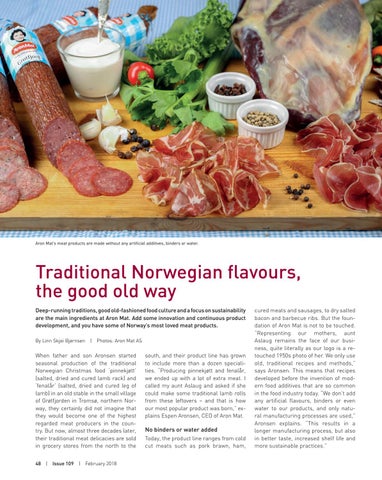Scan Magazine | Special Theme | A Taste of Norway
Aron Mat’s meat products are made without any artificial additives, binders or water.
Traditional Norwegian flavours, the good old way Deep-running traditions, good old-fashioned food culture and a focus on sustainability are the main ingredients at Aron Mat. Add some innovation and continuous product development, and you have some of Norway’s most loved meat products. By Linn Skjei Bjørnsen | Photos: Aron Mat AS
When father and son Aronsen started seasonal production of the traditional Norwegian Christmas food ‘pinnekjøtt’ (salted, dried and cured lamb rack) and ‘fenalår’ (salted, dried and cured leg of lamb) in an old stable in the small village of Grøtfjorden in Tromsø, northern Norway, they certainly did not imagine that they would become one of the highest regarded meat producers in the country. But now, almost three decades later, their traditional meat delicacies are sold in grocery stores from the north to the 48 | Issue 109 | February 2018
south, and their product line has grown to include more than a dozen specialities. “Producing pinnekjøtt and fenalår, we ended up with a lot of extra meat. I called my aunt Aslaug and asked if she could make some traditional lamb rolls from these leftovers – and that is how our most popular product was born,” explains Espen Aronsen, CEO of Aron Mat.
No binders or water added Today, the product line ranges from cold cut meats such as pork brawn, ham,
cured meats and sausages, to dry salted bacon and barbecue ribs. But the foundation of Aron Mat is not to be touched. “Representing our mothers, aunt Aslaug remains the face of our business, quite literally as our logo is a retouched 1950s photo of her. We only use old, traditional recipes and methods,” says Aronsen. This means that recipes developed before the invention of modern food additives that are so common in the food industry today. “We don’t add any artificial flavours, binders or even water to our products, and only natural manufacturing processes are used,” Aronsen explains. “This results in a longer manufacturing process, but also in better taste, increased shelf life and more sustainable practices.”
